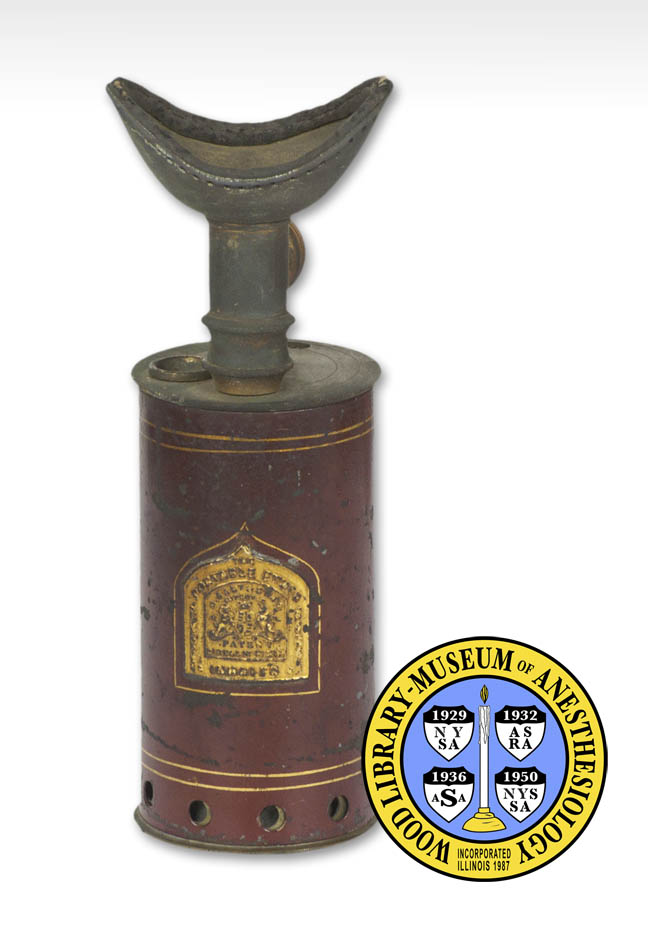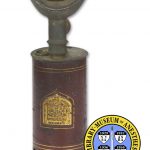Salt Inhaler
Salt & Son, the manufacturer of this inhaler, was a cutlery and surgical instrument making business with roots dating back to the early 1700s. This inhaler was patented on March 5, 1847, and the company promoted its portability. An ether-soaked sponge would be placed inside the inhaler, and the patient would breathe in the evaporated anesthetic (called "vapor") through the mouthpiece. Although made to deliver ether, it may also have been used to administer chloroform, which was introduced later in 1847.
Many of the earliest inhalers were made of glass, which is a poor conductor. As ether evaporated, the temperature inside a glass inhaler decreased significantly. This cooling reduced additional evaporation of the ether, limiting the duration of time a patient could remain anesthetized. It did not take long before other materials were used to construct new inhalers. Because Salt & Son chose to make this inhaler out of metal, it was a bit 'ahead of the curve.'
Catalog Record: Salt Inhaler
Access Key: aikl
Accession No.: 1989-02-10-1
Title: The portable ether inhaler / [made by] Salt & Son.
Corporate Author: Salt & Son.
Title variation: Alt Title
Title: Salt portable ether inhaler.
Publisher: Birmingham, [England] : M. Salt & Son, [ca. 1847].
Physical Description: 1 inhaler : brass alloy, steel[?] ; 19.5 x 7 x 7.5 cm.
Subject: Inhalers, Anesthesia – Great Britain.
Subject: Ether, Ethyl.
Subject: Anesthesia, Inhalation.
Note Type: General
Notes: Title from small metal plate on inhaler.
Note Type: Citation
Notes: Salts History. Salts Healthcare website. https://www.salts.co.
uk/about-us/salts-history.aspx. Accessed 7/25/2010.
Note Type: Physical Description
Notes: Brass cylindrical inhaler connected to metal mouthpiece; The cylinder, 6.5
cm in dia., is painted a burgundy color with gold-colored stenciling; Around
the base of the cylinder are approximately 10 perforations or openings; On
top of the cylinder is a small lever that can be slid from left to right;
Movement of the lever controls the size of the openings at the base, and thus
the amount of free air that is allowed into the sponge reservoir; An opening
on the top of the cylinder, near the mouthpiece, allows for the addition of
ether while the inhaler is in use; A brass ‘tube’ connects the mouthpiece to
the inhaler; Rivet holes dot the rim of the mouthpiece where it is lined with
a thin leather cushion; A metal plate of a yellow-gold color is centered on
the front of the body of the cylinder; Centered in the plate is a coat of
arms; Above the coat of arms is, “The Portable Ether Inhaler [new line] M.
Salt & Son’s [new line] Improved”; Below the coat of arms is, “Patent [new
line] 21 Bull St., Bir[mingham]”; Knob on the metal tube that attaches the
mouthpiece to the cylindrical body is also marked: “Registered 6 & 7 Vic. Cap
65, March 5, 1847, No. 988”.
Note Type: Reproduction
Notes: Photographed by Mr. William Lyle, July 14, 2010.
Note Type: Historical
Notes: Salt & Son was a cutler and surgical instrument making business with roots
dating back to the early 1700s (Salts History, 2010). Although made to
deliver ether, it may also have been used to administer chloroform.


